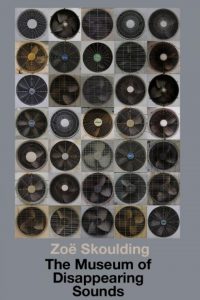The Museum of Disappearing Sounds
 This crashes around the skull. It whispers and it wails. It is the sound we hear when the space around us is silent. Recently shortlisted for the Ted Hughes award, Zoë Skoulding’s The Museum of Disappearing Sounds explores the notion of sound as a codependent relationship between a reader’s external and internal ear.
This crashes around the skull. It whispers and it wails. It is the sound we hear when the space around us is silent. Recently shortlisted for the Ted Hughes award, Zoë Skoulding’s The Museum of Disappearing Sounds explores the notion of sound as a codependent relationship between a reader’s external and internal ear.
The Museum of Disappearing Sounds is an intimate collection and is offered as a gift to you, her reader. You are the initiator, the listener, the viewer, and also the silencer of sound: “You hold [its] rise and decay.” The collection itself is curated like a display, divided into “exhibits.” An image of waves form in the second exhibit, enabling you to envision external noise internally. Skillfully, Skoulding wires sound deep within the body just as a set of cables connects to a radio.
In breathe a crackle of static disturbance
A detuned radio in one lung.
Throughout, Skoulding’s lines conscientiously compare the subconscious conflation of sight and sound. The adjective in the collection’s title, “Disappearing,” a word that hinges on visibility, introduces this thematic strand. In order to stimulate all senses, Skoulding also conflates sound with language, interpreting sound as speech. In “exhibit four”, “a voice shimmers.” Can a voice shine? “Can rhythms […] cradle?” In The Museum of Disappearing Sounds, words are imbued with secondary meanings. Skoulding’s poem replaces physical definitions with psychological emotions in an attempt to connect her reader’s senses. Answering the question above, “Cradle” suggests reassurance; consequently, a “cradling” voice comes to represent a comforting rhythm. The collection continues to inquire as to how one hears what is silent and feels what it untouchable.
By avoiding a conventional rhyme scheme, Skoulding’s poetry mirrors the un-calculated, uncontrolled noise of daily life through a focus on individual words. “Variants on a Polish Fragment” reiterates this point. It reads: “Words are sharp.” The word “sharp” itself not only acts as a familiar metaphor, but also an adjective to describe the concrete structure of an object. By pairing with “sharp” with “word,” Skoudling redefines it. This intentional reconstruction represents a combination of both sensory perceptions of “touch” and “sight.”
The Museum of Disappearing Sounds explores specific subjects in depth and compares them holistically. The third section of the collection contains a detailed inventory of both abstract and concrete objects. It concludes with a set of rooms, numbered unconventionally, beginning with 321 and finishing with 131. Sound here is personified. It speaks to you the reader. It says: “Today, I’m…” and continues to tell its story and warning that it will soon hide “where you can’t find it.” “I can do more dangerous things just with my eyes or crack the ground without even trying,” it recites in “Gwydyr Forest.” Giving “Sound” its own disposition, Skoulding raises the notion that it enables us to see: “I am speaking I am walking I am eating I am writing only I could have written this only you will read it” says “Sound.” A lack of punctuation endows that sense with the properties of an all-surrounding force, beating with a steady pulse. “Sound” is in everything you do. Ironically, in writing what was “not” written, but read aloud, Skoulding connects external noise with the “silent” sounds that you read in your head, know in your mind, and hear with your heart. The Museum of Disappearing Sounds accentuates the way that, despite the physical silence around us, we still hear “sound” when we see it created visually.
Zoe Skoulding secures the audible, preserving each sound as an artifact. Her collection, The Museum of Disappearing Sounds, deserves to be read with an ear in tune to its words. It is profoundly abstract, yet also real. By perusing Skoulding’s exhibitions, we, her readers, reconnect with a disregarded, integral part of our life’s cacophony.
Shanley McConnell

Leave a Reply